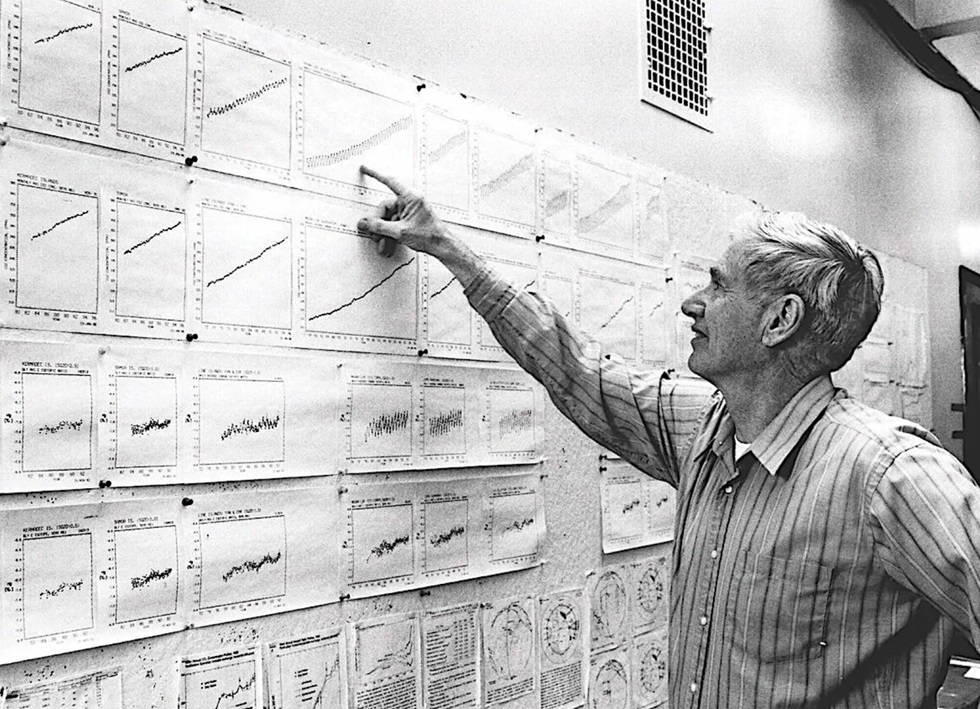
Newly discovered documents confirm that the petroleum and automobile industries funded the early climate science of Charles David Keeling at the California Institute of Technology (Caltech) from 1954 to 1956. Keeling became known for the “Keeling Curve,” which demonstrated the upward trajectory of the planet’s carbon dioxide levels.
The documents show that industry leaders were aware of the potential impacts of fossil fuels on the environment from early on.
Keeling traveled throughout the coastal areas, desert, forests, and grasslands of the western United States measuring background levels of carbon, DeSmog said in a detailed report.
A series of experiments atop the Mauna Loa volcano in Hawaii led to his famous curve — the foundation of today’s conception of human-caused climate change.
What the recently uncovered documents reveal is that this early research by Keeling was partially funded by “oil and auto companies” through the Southern California Air Pollution Foundation. The foundation was told of the potential future impacts of carbon dioxide emissions from human sources on people and the climate back in 1954.
The Southern California Air Pollution Foundation had been formed the previous year to address the issue of smog in Los Angeles. Some of the foundation’s donors were Ford, Chrysler, American Motors, and General Motors.
The automobile and oil companies gave $13,814 — approximately $158,000 today — toward the funding of Keeling’s work, the documents said, as reported by The Guardian.
An internal memo from the U.S. Public Health Service in 1959 also identified the Western Oil & Gas Association — now the Western States Petroleum Association — and the American Petroleum Institute (API) as “major contributors to the funds of the Air Pollution Foundation,” DeSmog reported.
Beginning in mid-1955, the foundation’s board of trustees was kept abreast of research projects through a “technical advisory committee,” members of which included scientists from Chrysler and the Richfield Oil Corporation — today BP — and a senior API official.
“With the discovery of these Air Pollution Foundation documents, it is now possible to date the earliest sponsorship of climate science by the fossil fuel industry to 1954, approximately a quarter of a century before Exxon’s internal research program of the late 1970s,” DeSmog said. “These new documents provide important evidence that the fossil fuel industry has been intricately connected to climate science from its earliest beginnings — not only as a driver of the greenhouse effect behind climate change but also as a contributor to the scientific discoveries that would transform our understanding of humanity’s relationship with the Earth and its atmosphere.”
DeSmog pointed out that more than three decades after its initial warnings about carbon dioxide’s potential climate impacts, “numerous members and sponsors” of the foundation — including Chevron, BP, API, and the Automobile Manufacturers Association — helped start a multi-million dollar assault on climate policies to address global heating while also promoting the denial of climate science funded in part by themselves.
“You just come back to the oil and gas industry again and again, they were omnipresent in this space,” said Carroll Muffett, the Center for International Environmental Law’s chief executive, as reported by The Guardian. “The industry was not just on notice but deeply aware of the potential climate implications of its products for going on 70 years.”
Newly revealed correspondence shows the Caltech research proposal was sent by Samuel Epstein — Keeling’s research director — to the Air Pollution Foundation in November of 1954. The proposal highlighted the potential climate impacts from burning “coal and petroleum,” as well as the promise of a new carbon isotope analysis method to pinpoint “changes in the atmosphere.”
Epstein noted that the “possible consequences of a changing concentration of the CO2 in the atmosphere with reference to climate… may ultimately prove of considerable significance to civilization,” DeSmog reported.
According to a 1955 Air Pollution Foundation Statement of Policy, a third of the foundation’s trustees were from industries “which are or may be contributors in some degree to air pollution,” indicating they were fully aware of the connection between the trustees — which included the president of Chevron (then Union Oil), North American Aviation, Western Airlines, Southern Pacific Railroad, Chrysler, Western Consolidated Steel, and Charles F. Kettering, General Motors’ director of research laboratories — and the pollution their companies were generating.
“The principal reason for their membership on the Board, in addition to their recognized standing in the community, is to make certain that they will be parties to all facts and evidence brought to light on the problem so that they and their colleagues in like enterprises can continue to devote their best efforts toward the abatement of air pollution,” the policy statement said.
The data compiled in a paper by Keeling from 1956, “The Concentration and Isotopic Composition of Atmospheric Carbon Dioxide,” was funded by a grant from the Air Pollution Foundation. It shows how carbon emissions measurements Keeling took above tropical waters and at various U.S. locations were consistently similar and highlighted the broader scope of his research in predicting the effects of burning fossil fuels on the atmosphere.
“The factors which control the concentration and isotopic composition of carbon dioxide in the earth’s atmosphere have been studied with the view of predicting the effect of terrestrial plants, of surface ocean water, and of the burning of coal and petroleum on atmospheric carbon dioxide,” Keeling wrote.
This article was reposted from EcoWatch.
We hope you appreciated this article. At People’s World, we believe news and information should be free and accessible to all, but we need your help. Our journalism is free of corporate influence and paywalls because we are totally reader-supported. Only you, our readers and supporters, make this possible. If you enjoy reading People’s World and the stories we bring you, please support our work by donating or becoming a monthly sustainer today. Thank you!









